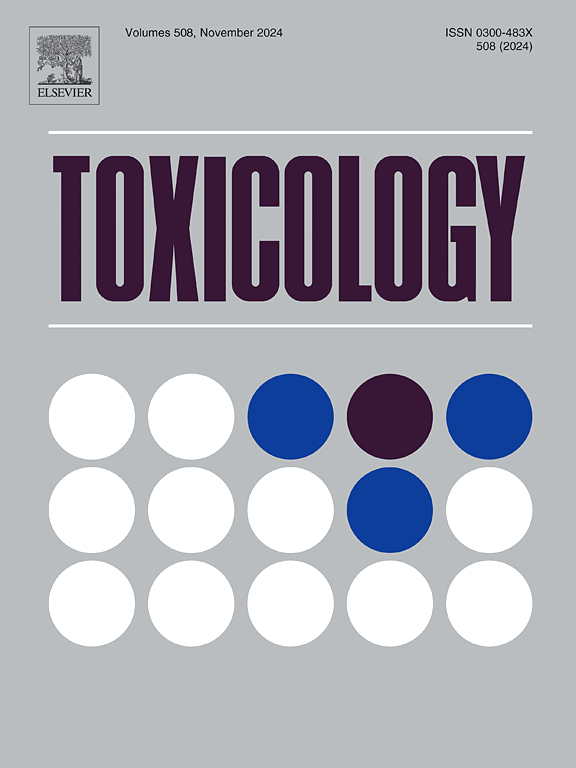In vitro to in vivo extrapolation modeling to facilitate the integration of transcriptomics data into genotoxicity assessment
IF 4.6
3区 医学
Q1 PHARMACOLOGY & PHARMACY
引用次数: 0
Abstract
In vitro transcriptomics holds promise for high-throughput, human-relevant data but is not yet integrated into regulatory decision-making due to the lack of standardized approaches. For genotoxicity assessment, transcriptomic biomarkers such as GENOMARK and TGx-DDI facilitate qualitative and quantitative analysis of complex in vitro transcriptomic datasets. However, advancing their use in quantitative testing requires standardized methods for deriving transcriptomic Points of Departure (tPoDs) and linking them to in vivo responses. Herein, we investigated different approaches to calculate tPoDs and applied in vitro to in vivo extrapolation to obtain administered equivalent doses (AEDs). Human HepaRG cells were exposed for 72 h to 10 known in vivo genotoxicants (glycidol, methyl methanesulfonate, nitrosodimethylamine, 4-nitroquinoline-N-oxide, aflatoxin B1, colchicine, cyclophosphamide, mitomycin C, ethyl methanesulfonate, and N-Nitroso-N-ethylurea) from the highest concentration that induces up to 50 % cytotoxicity through a range of lower concentrations. Gene expression data was generated using a customized version of the TempO-Seq® human S1500 + gene panel. The GENOMARK and TGx-DDI biomarkers produced genotoxic calls for all of these reference genotoxicants. Next, we performed benchmark concentration (BMC) modeling to generate both genotoxicity-specific biomarker (tPoDbiomarkers) and generic tPoDs (tPoD S1500+). High-throughput toxicokinetic models estimated the human AEDs for these tPoDs, which were compared with (a) previously reported genotoxicity-specific AEDs from other New Approach Methodologies, and (b) in vivo PoDs from animal studies. We found that the generic AEDs were more conservative than genotoxicity-specific biomarker AEDs. For six of the nine genotoxicants, transcriptomic AEDs were lower than the in vivo PoDs; refined kinetic models may improve predictions. Overall, in vitro transcriptomic data in HepaRG cells provide protective estimates of in vivo genotoxic concentrations, consistent with other in vitro genotoxicity testing systems.
体外到体内外推模型,以促进转录组学数据整合到遗传毒性评估
体外转录组学有望获得高通量、与人类相关的数据,但由于缺乏标准化的方法,尚未整合到监管决策中。对于遗传毒性评估,转录组生物标志物(如GENOMARK和TGx-DDI)有助于对复杂的体外转录组数据集进行定性和定量分析。然而,推进它们在定量测试中的应用需要标准化的方法来获得转录组起始点(tpod)并将它们与体内反应联系起来。在此,我们研究了计算tpod的不同方法,并应用体外到体内的外推法来获得给药当量剂量(aed)。人类HepaRG细胞从最高浓度暴露于10种已知的体内基因毒物(甘油三酯、甲磺酸甲酯、亚硝基二甲胺、4-硝基喹啉-n -氧化物、黄曲霉毒素B1、秋水仙碱、环磷酰胺、丝裂霉素C、甲磺酸乙酯和n -亚硝基-n -乙基脲)72 h,通过一系列较低浓度诱导高达50% %的细胞毒性。基因表达数据使用定制版本的TempO-Seq®人S1500 + 基因面板生成。GENOMARK和TGx-DDI生物标志物对所有这些参考基因毒物产生了基因毒性。接下来,我们进行基准浓度(BMC)建模,以生成基因毒性特异性生物标志物(tPoD生物标志物)和通用tPoD (tPoD S1500+)。高通量毒性动力学模型估计了这些tpod的人类aed,并将其与(a)先前报道的其他新方法方法的基因毒性特异性aed,以及(b)来自动物研究的体内pod进行了比较。我们发现,通用aed比基因毒性特异性生物标志物aed更保守。对于9种基因毒物中的6种,转录组AEDs低于体内pod;精细的动力学模型可以改进预测。总的来说,HepaRG细胞的体外转录组学数据提供了体内遗传毒性浓度的保护性估计,与其他体外遗传毒性测试系统一致。
本文章由计算机程序翻译,如有差异,请以英文原文为准。
求助全文
约1分钟内获得全文
求助全文
来源期刊

Toxicology
医学-毒理学
CiteScore
7.80
自引率
4.40%
发文量
222
审稿时长
23 days
期刊介绍:
Toxicology is an international, peer-reviewed journal that publishes only the highest quality original scientific research and critical reviews describing hypothesis-based investigations into mechanisms of toxicity associated with exposures to xenobiotic chemicals, particularly as it relates to human health. In this respect "mechanisms" is defined on both the macro (e.g. physiological, biological, kinetic, species, sex, etc.) and molecular (genomic, transcriptomic, metabolic, etc.) scale. Emphasis is placed on findings that identify novel hazards and that can be extrapolated to exposures and mechanisms that are relevant to estimating human risk. Toxicology also publishes brief communications, personal commentaries and opinion articles, as well as concise expert reviews on contemporary topics. All research and review articles published in Toxicology are subject to rigorous peer review. Authors are asked to contact the Editor-in-Chief prior to submitting review articles or commentaries for consideration for publication in Toxicology.
 求助内容:
求助内容: 应助结果提醒方式:
应助结果提醒方式:


